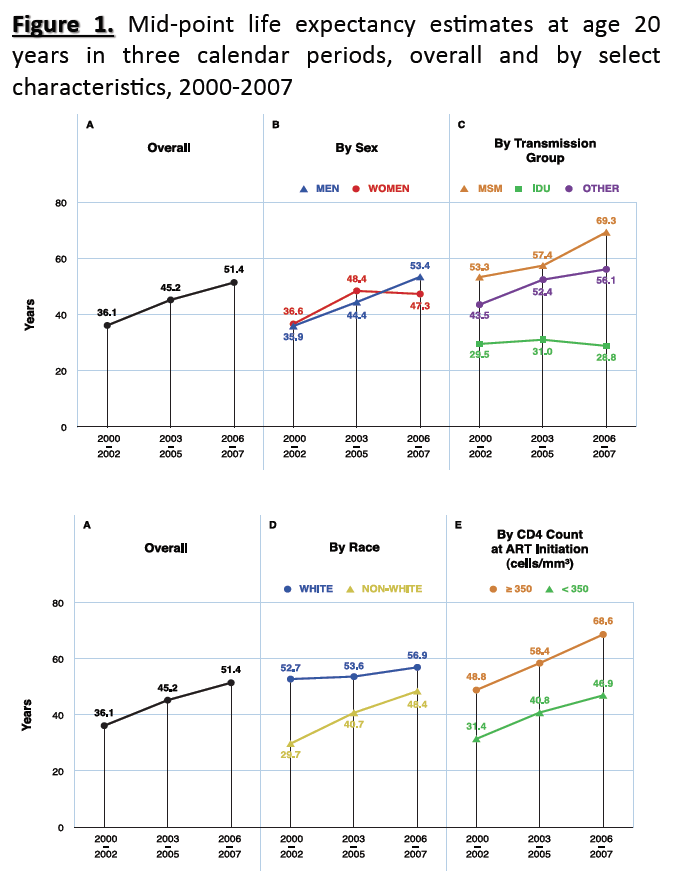 |
 |
 |
| |
Life Expectancy With HIV Jumps 15 Years From 2000-2002 to 2006-2007 in US, Canada
|
| |
| |
7th IAS Conference on HIV Pathogenesis, Treatment and Prevention, June 30-July 3, 2013, Kuala Lumpur
Mark Mascolini
Life expectancy among antiretroviral-treated HIV-positive people in the United States and Canada rose substantially during the 2000s, approaching life expectancy estimates in the general population [1]. But certain subgroups, including nonwhites and people who start antiretroviral therapy (ART) at a CD4 count below 350, still greatly lag the general population in life expectancy, according to this North American AIDS Cohort Collaboration on Research and Design (NA-ACCORD) analysis.
NA-ACCORD investigators conducted this study to estimate changes in life expectancy among antiretroviral-naive adults in the United States and Canada who started antiretroviral therapy from 2000 through 2007. All cohort members analyzed were at least 20 years old. The NA-ACCORD team calculated person-time for each participant from January 1, 2000 or ART initiation until death, loss to follow-up, or December 31, 2007. They estimated life expectancy at age 20, defined as the average number of additional years that person will live if current age-specific mortality rates remain constant.
The study population included 22,937 people, 62% of them white and 23% women. Crude mortality was 19.8 per 1000 person-years, meaning about 20 of every 1000 people died every year. Mortality was similar in women and men (19.1 and 20.0 per 1000), but significantly higher among people who acquired HIV through injection drug use than among those who became infected during sex between men or by other routes (34.5 versus 12.5 versus 19.1 per 1000). Crude mortality was significantly lower in whites than nonwhites (16.0 versus 22.4 per 1000). Mortality was also significantly lower among people who started ART at a CD4 count above 350 than among those who started at a lower count (11.3 versus 22.3 per 1000).
Overall life expectancy at age 20 rose from 36.1 in 2000-2002 to 45.2 in 2003-2005, and to 51.4 in 2006-2007. The 2006-2007 estimate means a 20-year-old starting antiretroviral therapy in those years could expect to live to age 71.4. Women and men had comparable life expectancy in the first two study periods (2000-2002 and 2003-2005), but men had a 6.1-year longer life expectancy in 2006-2007 (53.4 versus 47.3).
Among men infected during sex with men, life expectancy at age 20 climbed from 53.3 in 2000-2002 to 57.4 in 2003-2005 and to 69.3 in 2006-20007. So a 20-year-old man starting treatment in 2006-2007 could expect to live to 89.3. In contrast, life expectancy among injection drug users was much lower and did not improve over those three periods: 29.5, 31.0, and 28.8. Among people infected by another route, life expectancy jumped from 43.5 in 2000-2002, to 52.4 in 2003-2005, and to 56.1 in 2006-2007.
Life expectancy at age 20 among whites remained fairly stable over the three study periods, inching up from 52.7 in 2000-2002, to 53.6 in 2003-2005, and to 56.9 in 2006-2007. In those same three periods, life expectancy among nonwhites rose rapidly but still far lagged life expectancy among whites in the third period: 29.7 in 2000-2002, to 40.7 in 2003-2005, and 48.4 in 2006-2007.
Among people who started ART at a CD4 count above or below 350, life expectancy at age 20 rose steadily in both groups but remained much lower in the sub-350 group in every study period:
Life expectancy at age 20 when ART starts above versus below 350 CD4s:
-- 2000-2002: 48.8 versus 31.4
-- 2003-2005: 58.4 versus 40.8
-- 2006-2007: 68.6 versus 46.9
The NA-ACCORD team concluded that "a 20-year-old HIV-positive individual on ART in the US or Canada is expected to live into their early 70s, a life expectancy approaching that in the general population." But HIV-positive women, nonwhites, injection drug users, and people starting ART with fewer than 350 CD4s still trail HIV-positive comparison groups and the general population in life expectancy.
Reference
1. Hogg RS, Althoff KN, Samji H, et al. Increases in life expectancy among treated HIV-positive individuals in the United States and Canada, 2000-2007. 7th IAS Conference on HIV Pathogenesis, Treatment and Prevention, June 30-July 3, 2013, Kuala Lumpur. Abstract TUPE260.





|
| |
|
 |
 |
|
|